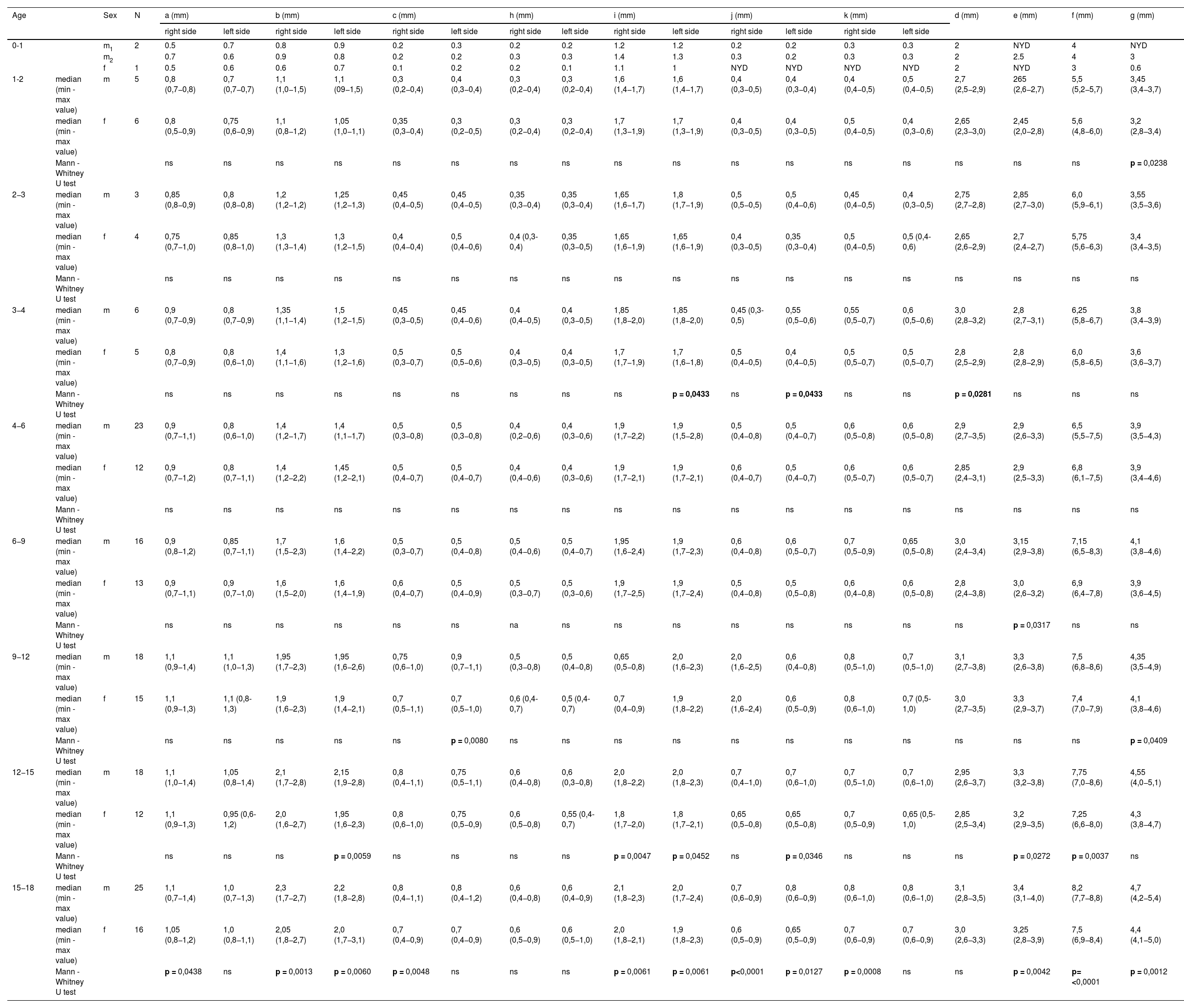The objective of the study was: (1) to describe changes in the shape of the atlas during growth, including gender and side differences; (2) to assess the dimension essential for identification of the optimal entry point; (3) to determine the age limit for a safe insertion of 3.5-mm screws into the lateral masses according to our own limiting parameters.
Materials and methodsDimensions of the atlas were measured on 200 CT scans of the craniocervical junction in individuals aged 0–18 years and on 34 anatomical specimens of the first cervical vertebra (aged 2.5–18 years). Both series were divided according to the gender and age. The values measured on CT scans were used for statistical comparison of data in boys and girls and comparison of the right and left sides.
ResultsThe atlas reaches its maximum growth rate between 0 and 2 years of age, then the growth decelerates and continues until the age of 18 years. The proportion of dimensions of C1 vertebral foramens changes with age. The youngest children show a relatively greater distance from the left to the right medial pedicle; around the age of 5 the values get even and subsequently the distance from the inner wall of anterior to posterior arch gets relatively greater. The transverse foramen has a slightly oval shape throughout the period of growth. Statistically significant differences between boys and girls were observed primarily between 12 and 18 years of age.
ConclusionThe study has proved adequate size of lateral masses for insertion of 3.5-mm screws in all patients from the age of 5 years. In younger children, the patient´s anatomy should be respected and the surgical technique tailored accordingly.
El objetivo del estudio era: (1) describir los cambios en la forma del atlas durante el crecimiento, incluyendo las diferencias de género y de lado; (2) evaluar la dimensión esencial para la identificación del punto de entrada óptimo; (3) determinar el límite de edad para una inserción segura de tornillos de 3,5 mm en las masas laterales según nuestros propios parámetros limitantes.
Materiales y métodosLas dimensiones del atlas se midieron en 200 TC (tomografías computarizadas) de la unión craneocervical en individuos de 0 a 18 años y en 34 especímenes anatómicos de la primera vértebra cervical (de 2,5 a 18 años). Ambas series se dividieron según el género y la edad. Los valores medidos en las tomografías computarizadas se utilizaron para la comparación estadística de los datos en niños y niñas y para la comparación de los lados derecho e izquierdo.
ResultadosEl atlas alcanza su tasa de crecimiento máxima entre los 0 y los 2 años de edad, después el crecimiento se desacelera y continúa hasta los 18 años. La proporción de las dimensiones de los forámenes vertebrales C1 cambia con la edad. Los niños más jóvenes muestran una distancia relativamente mayor del pedículo medial izquierdo al derecho; alrededor de los 5 años los valores se igualan y posteriormente la distancia de la pared interna del arco anterior al posterior se vuelve relativamente mayor. El foramen transverso tiene una forma ligeramente ovalada durante todo el período de crecimiento. Se observaron diferencias estadísticamente significativas entre niños y niñas principalmente entre los 12 y los 18 años de edad.
ConclusiónEl estudio ha demostrado un tamaño adecuado de las masas laterales para la inserción de tornillos de 3,5 mm en todos los pacientes a partir de los 5 años de edad. En el caso de niños más pequeños, es necesario respetar la anatomía del paciente y adaptar la técnica quirúrgica en consecuencia.
Article

If it is the first time you have accessed you can obtain your credentials by contacting Elsevier Spain in suscripciones@elsevier.com or by calling our Customer Service at902 88 87 40 if you are calling from Spain or at +34 932 418 800 (from 9 to 18h., GMT + 1) if you are calling outside of Spain.
If you already have your login data, please click here .
If you have forgotten your password you can you can recover it by clicking here and selecting the option ¿I have forgotten my password¿.










